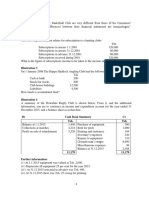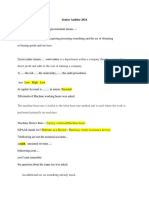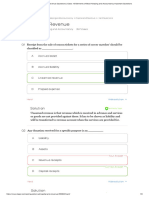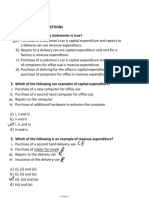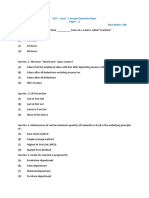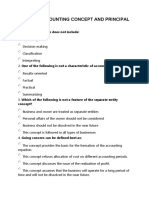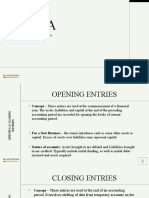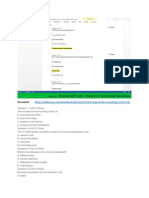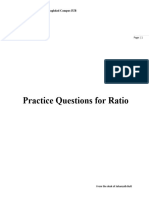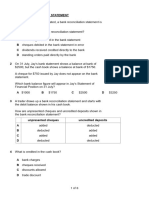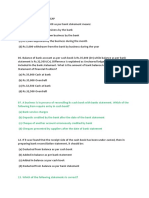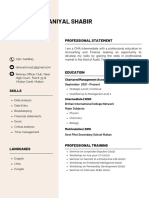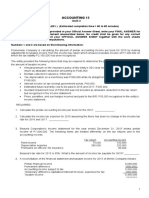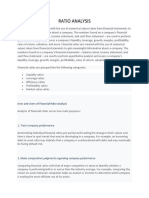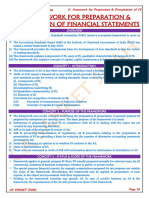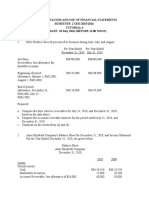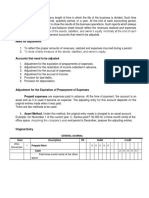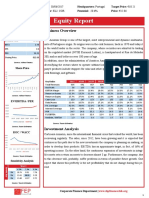TEST: BAD AND DOUBTFUL DEBTS MARKS = 20
Taha Popatia
1. Minahil, one of the customers of JSS Industries, paid Rs. 25,000 against bad debts
written off in the previous year.
What entry should be passed in the books of JSS Industries?
(a) Dr. Cash and Cr. Accounts receivables
(b) Dr. Cash and Cr. Allowance for doubtful debts
(c) Dr. Cash and Cr. Bad debts expense
(d) Dr. Cash and Cr. Accounts payable
2. After finalizing the adjustments, it was found that the opening allowance for doubtful
debts was overstated and the wrong amount was charged to the statement of profit and
loss account.
What was the impact on net profit and net assets for the current year on account of the
above error?
(a) Profit was understated by double amount
(b) Profit was overstated by double amount
(c) Profit was understated by single amount
(d) Profit was overstated by single amount
3. Which TWO of the following entries can be passed if bad debts were recovered
during the year?
(a) Dr. Bad debts expense and Cr. Accounts receivables
(b) Dr. Accounts receivables and Cr. Bad debts expense
(c) Dr. Cash and Cr. Bad debts expense
(d) Dr. Cash and Cr. Bad debts recovered
4. Accounts receivables as at 31 December 2022 was Rs. 475,000. At the end of the
year, a specific allowance was created against the following customers:
AM Traders Receivable Rs. 25,000 (80% allowance)
JM Traders Receivable Rs. 18,000 (50% allowance)
The estimate of the general allowance was 5% of receivables.
Which of the following is the correct treatment for calculating the general allowance?
(a) General allowance of 5% should be calculated on Rs. 475,000
(b) General allowance of 5% should be calculated on Rs. 455,300
(c) General allowance of 5% should be calculated on Rs. 446,000
(d) General allowance of 5% should be calculated on Rs. 432,000
5. Which of the following is NOT a reason for recording doubtful debts in books?
(a) Customer is in severe financial difficulties
(b) Customer was declared bankrupt and the liquidator confirmed that no amount
could be paid to our business
(c) Customer took too long to pay its debts
(d) Customer facing operational difficulties like strikes etc.
1|Page
PRC-04: Introduction to Accounting
�TEST: BAD AND DOUBTFUL DEBTS MARKS = 20
Taha Popatia
6. The accounts receivables (net) of a company at June 30, 2022 (after deducting
specific allowance) was Rs. 342,000. The company created an allowance of Rs.
38,000 as at June 30, 2022, including 5% general allowance in respect of doubtful
debts.
The amount of specific allowance was:
(a) Rs. 20,000
(b) Rs. 20,900
(c) Rs. 19,000
(d) Rs. 15,200
7. Allowance for doubtful debts is:
(a) Asset account
(b) Liability account
(c) Contra for asset account
(d) Contra for liability account
8. While preparing the aging analysis of accounts receivables, the following customers
were highlighted who have not paid within the credit period.
From the company’s point of view, which customer carries more risk of bad debts?
(a) Musa Trading owed Rs. 50,000 and classified in 30-60 days past due
(b) Jamal Sons owed Rs. 40,000 and classified in 120 days past due
(c) Rukhsar Enterprises owed Rs. 30,000 and classified in 1-30 days past due
(d) Mukhtar Industries owed Rs. 100,000 and amount not yet due
9. Which of the following net amounts is charged to the profit and loss account during
the year?
(a) Bad debts written off + bad debts to be written off + decrease in allowance – bad
debts recovered
(b) Bad debts written off + bad debts to be written off + increase in allowance – bad
debts recovered
(c) Bad debts written off + bad debts to be written off + decrease in allowance + bad
debts recovered
(d) Bad debts written off + bad debts to be written off - increase in allowance – bad
debts recovered
2|Page
PRC-04: Introduction to Accounting
�TEST: BAD AND DOUBTFUL DEBTS MARKS = 20
Taha Popatia
10. Receivables balances at the start and end of the year were Rs. 175,000 and Rs.
193,000, respectively, while discount allowed was Rs. 6,000, discount received was
Rs. 3,000, bad debts written off amounted to Rs. 2,000, bad debts to be written off
totaled Rs. 4,000, the increase in allowance for doubtful debts was Rs. 6,700, cheques
received from suppliers amounted to Rs. 53,000, cheques received from customers
were Rs. 356,000, cash sales amounted to Rs. 45,000, and sales returns totaled Rs.
6,000, (of which one-third related to cash sales).
What will be the net credit sales for the year?
(a) Rs. 382,000
(b) Rs. 427,000
(c) Rs. 425,000
(d) Rs. 431,000
11. Which of the following transactions will affect the receivable account?
(a) Bad debts expense
(b) Allowance for bad debts
(c) Purchase return
(d) Trade discount
12. Bad debts recovered is recognised as:
(a) Increase in allowance
(a) Other income
(b) An expense
(c) None of these
13. At 31 December 2021, an entity's allowance for doubtful receivables amounted to
Rs. 48,000, which was 5% of the receivables at that date. At 31 December 2022,
receivables totalled Rs. 1,085,000. It was decided to write off Rs. 53,000 of debt as
irrecoverable and based on past experience, to keep the allowance for doubtful
receivables at 5% of receivables.
What should be the charge in the Profit and Loss (P/L) for the year ended 31
December 2022 for bad and doubtful receivables?
(a) Rs. 59,250
(b) Rs. 56,600
(c) Rs. 49,400
(d) Rs. 46,750
3|Page
PRC-04: Introduction to Accounting
�TEST: BAD AND DOUBTFUL DEBTS MARKS = 20
Taha Popatia
14. Which of the following statements are correct?
(1) The good debts do not require any special accounting treatment unlike bad and
doubtful debts.
(II) The doubtful debts must stay in the accounting records so that the business
continues to chase payment.
Select the most appropriate answer:
(a) Only (1) is correct
(b) None is correct
(c) Both are correct
(d) Only (II) is correct
15. The journal entry to record a decrease in allowance during the year was:
(a) Dr. Bad debt expense Cr. Allowance for doubtful debts
(b) Dr. Accounts receivables Cr. Allowance for doubtful debts
(c) Dr. Allowance for doubtful debts Cr. Bad debt expense
(d) Dr. Allowance for doubtful debts Cr. Accounts receivables
16. Which of the following can be most relevant to the calculation of allowance
for doubtful debts?
(a) Total credit sales
(b) Total credit purchases
(c) Total current assets
(d) Total current liabilities
17. Accounts receivables as at 31 December 2022 was Rs. 475,000. At the end of
the year, a specific allowance was created against the following customers:
AM Traders Receivable Rs. 25,000 (80% allowance)
JM Traders Receivable Rs. 18,000 (50% allowance)
The estimate of the general allowance was 5% of receivables.
Which of the following is the correct treatment for calculating the general allowance?
(a) General allowance of 5% should be calculated on Rs. 475,000
(b) General allowance of 5% should be calculated on Rs. 455,300
(c) General allowance of 5% should be calculated on Rs. 446,000
(d) General allowance of 5% should be calculated on Rs. 432,000
4|Page
PRC-04: Introduction to Accounting
�TEST: BAD AND DOUBTFUL DEBTS MARKS = 20
Taha Popatia
18. Which of the following receivables have the highest probability to default on
trade debts?
(a) Current month receivables
(b) Over 90 days old receivables
(c) 60 to 90 days old receivables
(d) 30 to 60 days old receivables
19. Allowance for doubtful debts is:
(a) Asset account
(b) Liability account
(c) Contra for asset account
(d) Contra for liability account
20. Which of the following net amounts is charged to the profit and loss account
during the year?
(a) Bad debts written off + bad debts to be written off + decrease in allowance –
bad debts recovered
(b) Bad debts written off + bad debts to be written off + increase in allowance –
bad debts recovered
(c) Bad debts written off + bad debts to be written off + decrease in allowance +
bad debts recovered
(d) Bad debts written off + bad debts to be written off - increase in allowance – bad
debts recovered
5|Page
PRC-04: Introduction to Accounting















